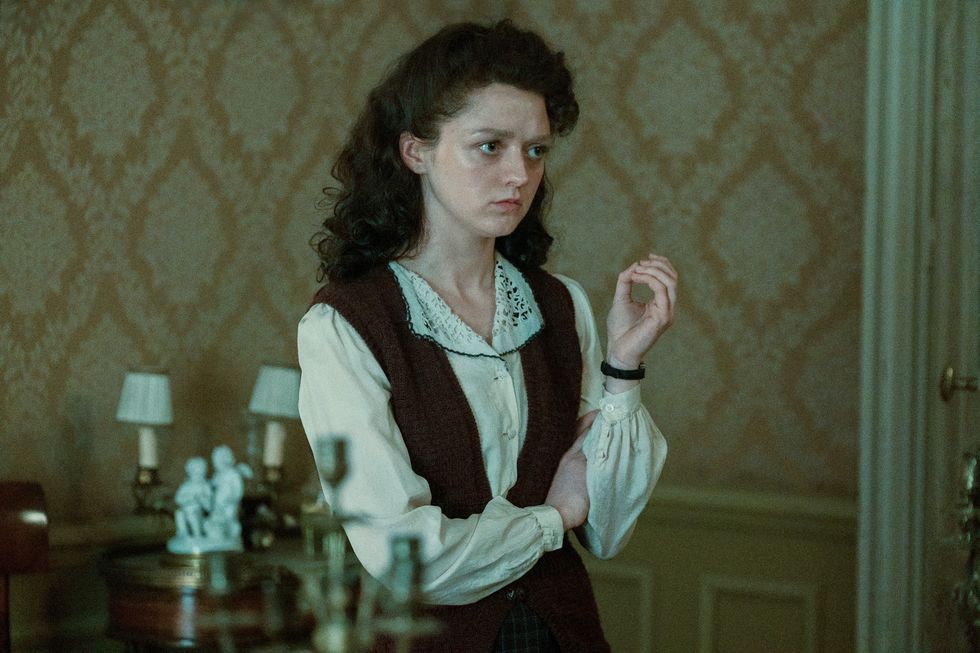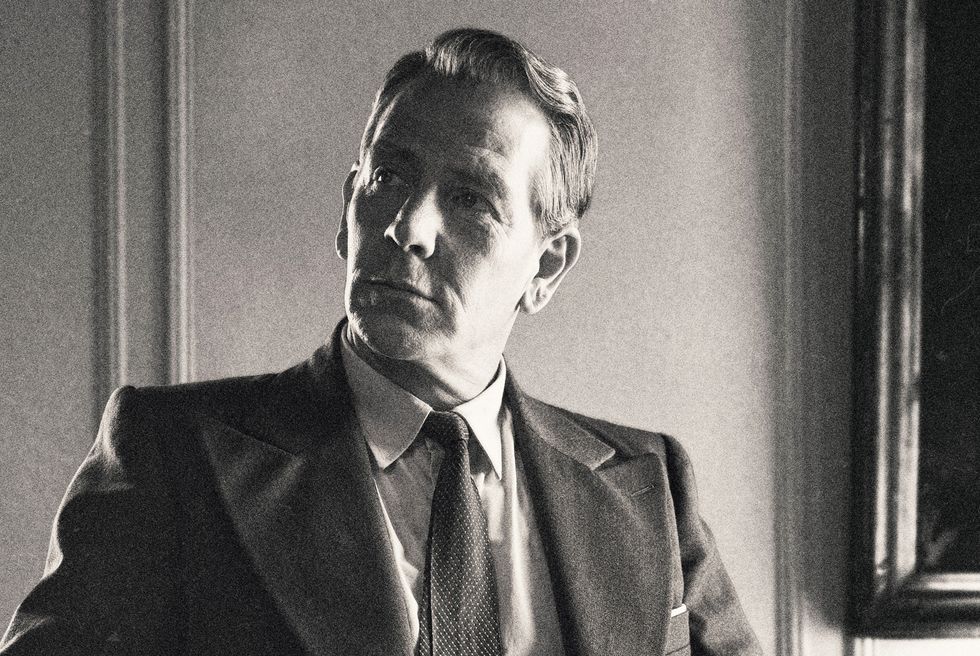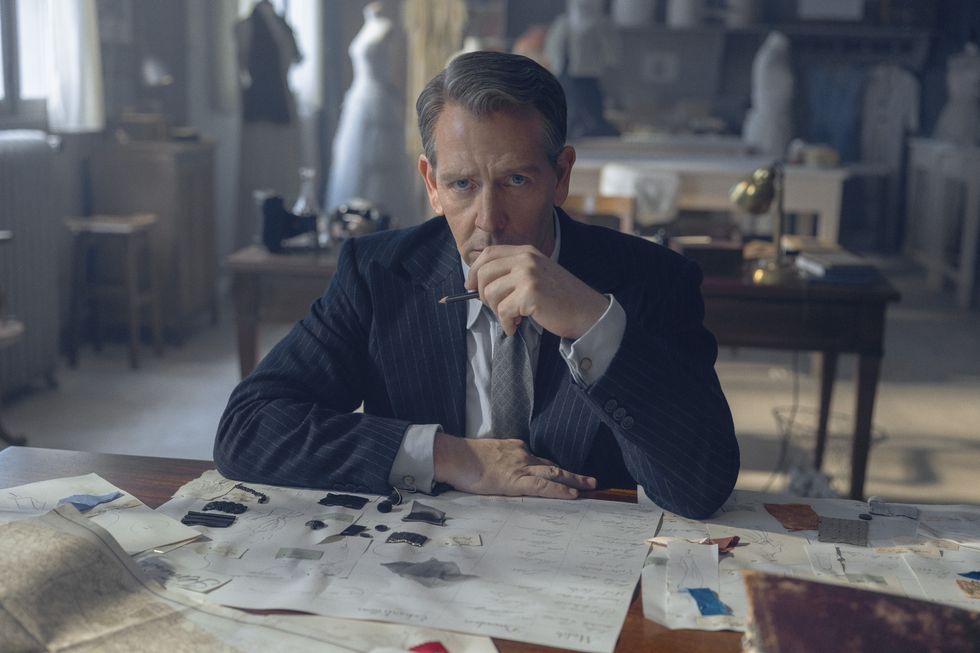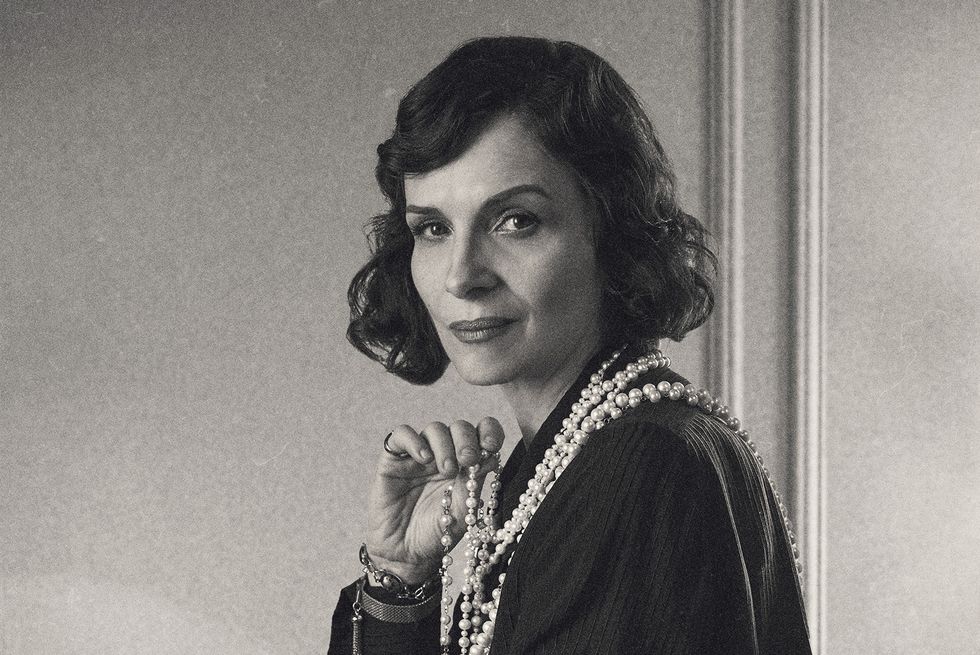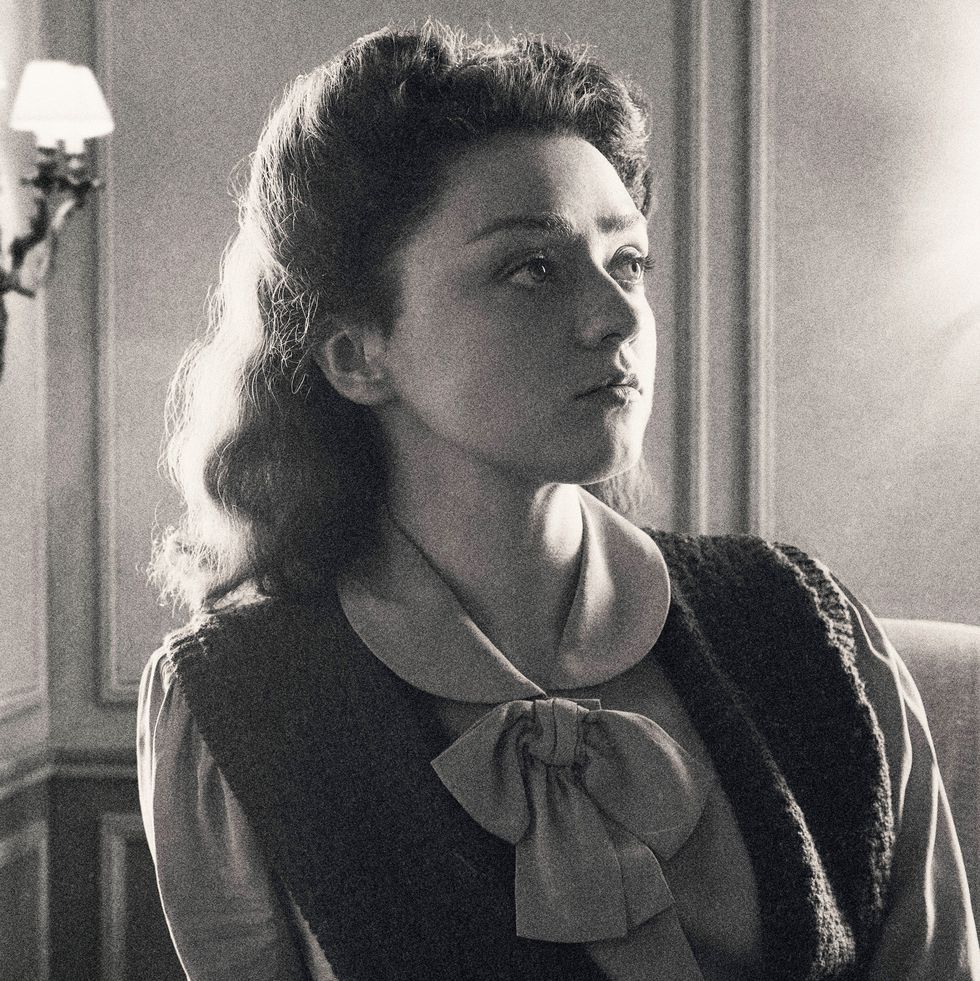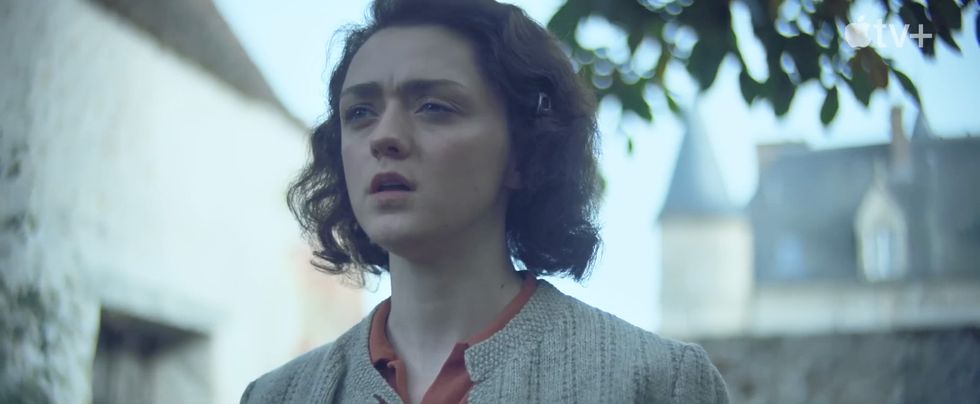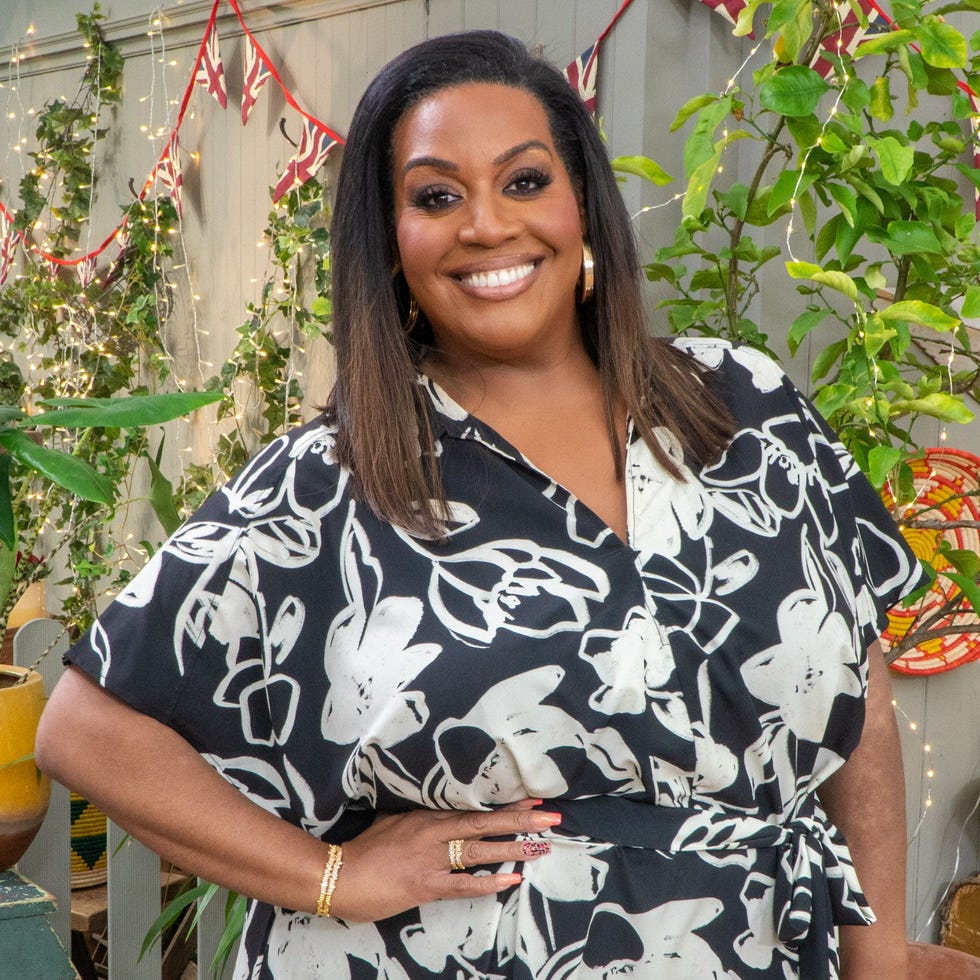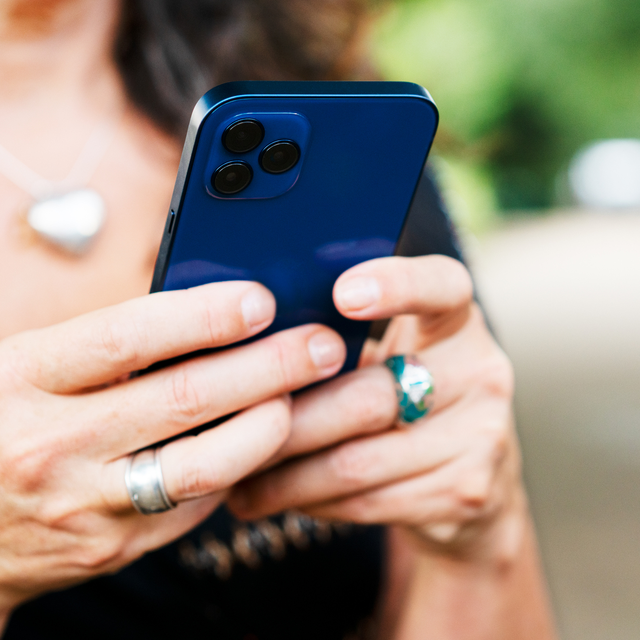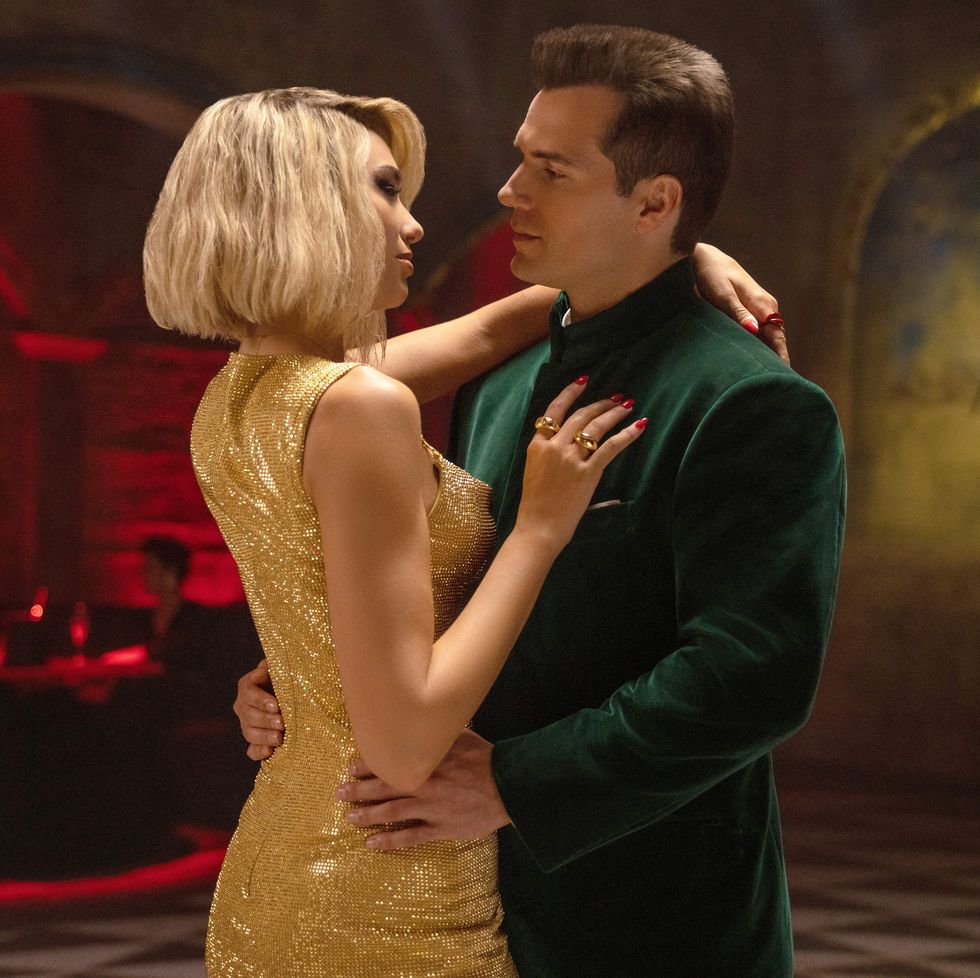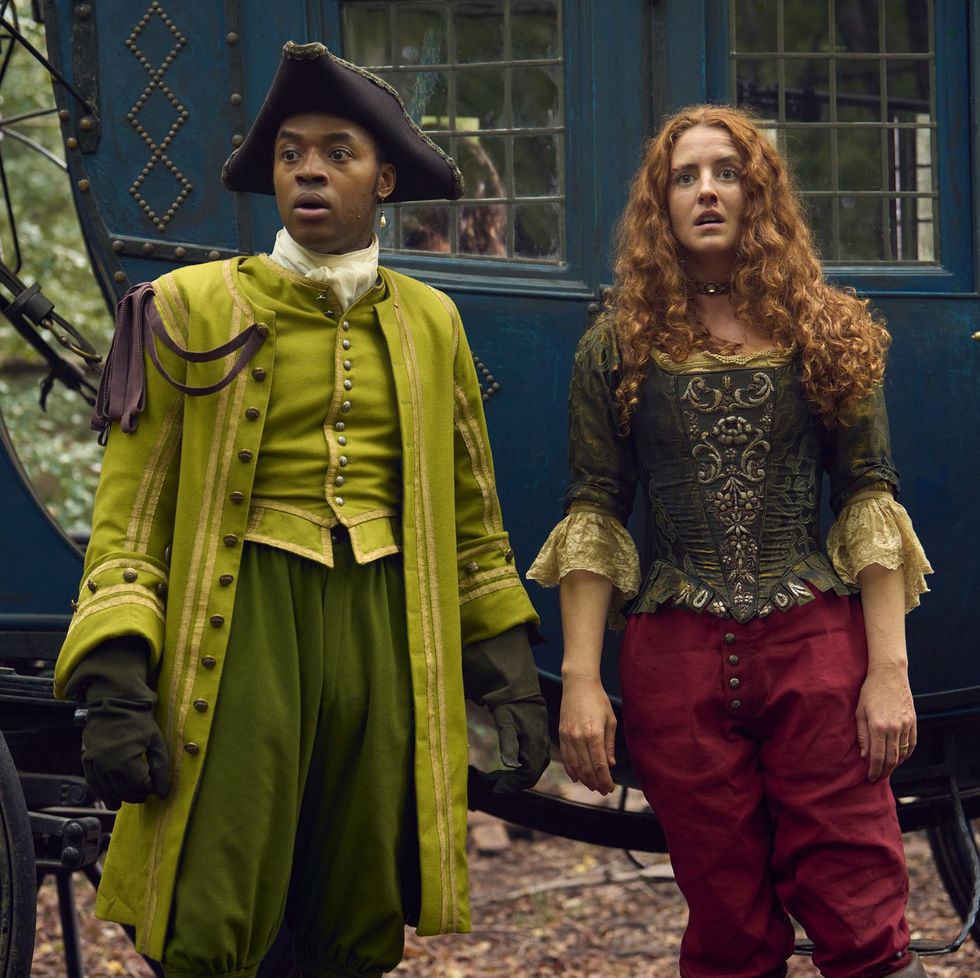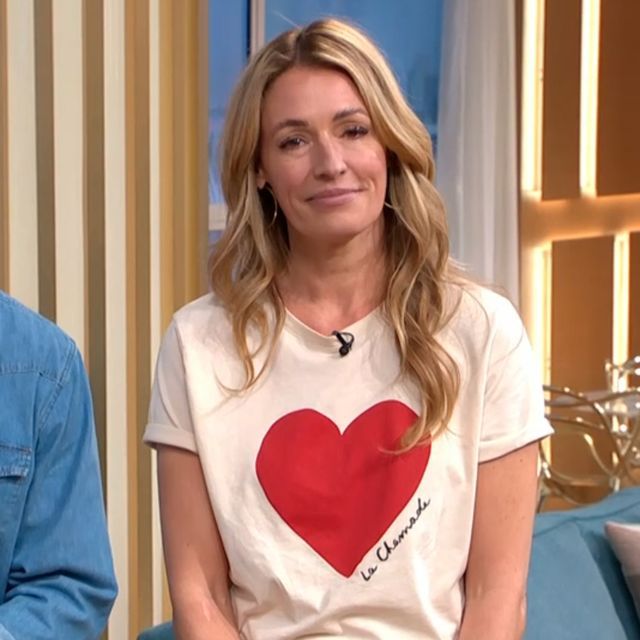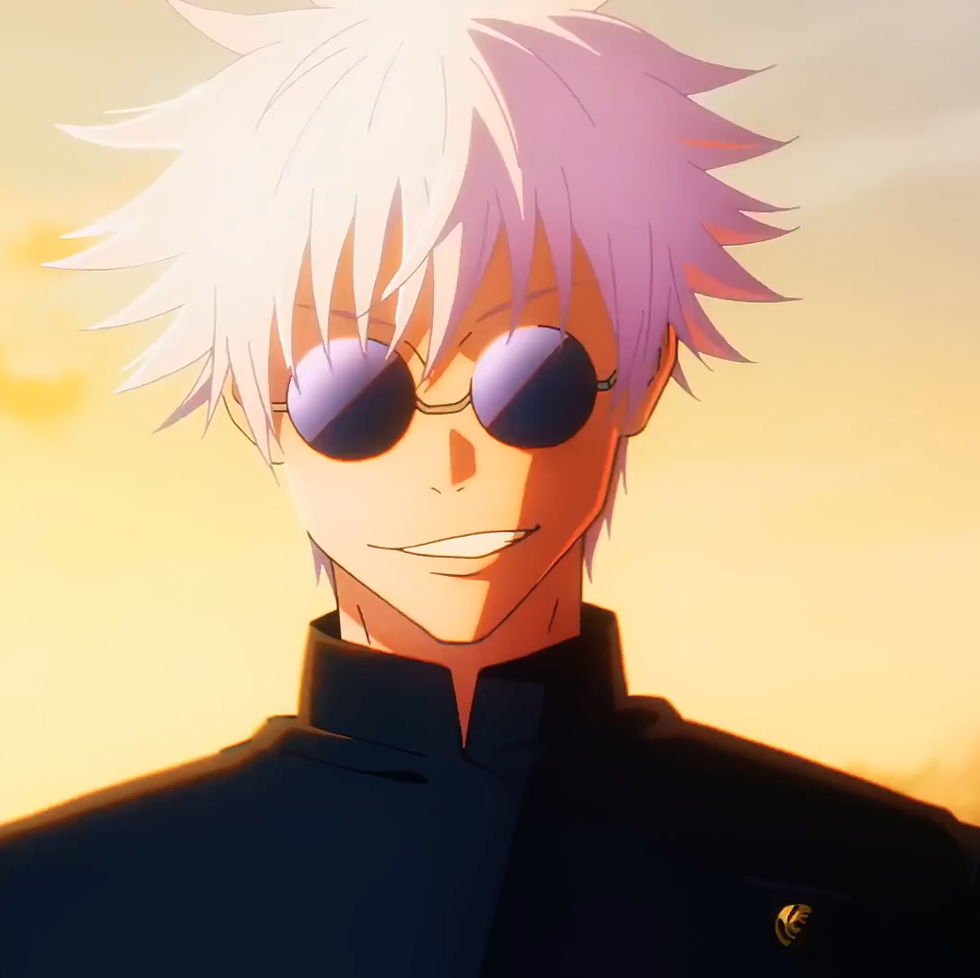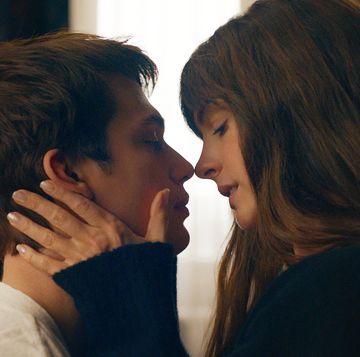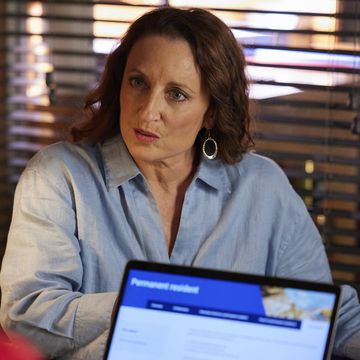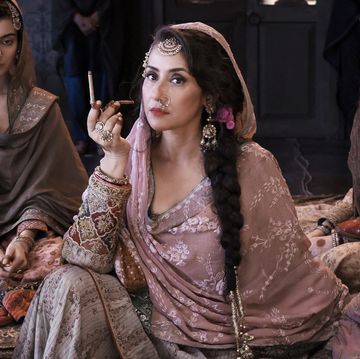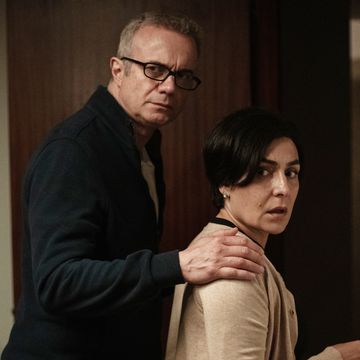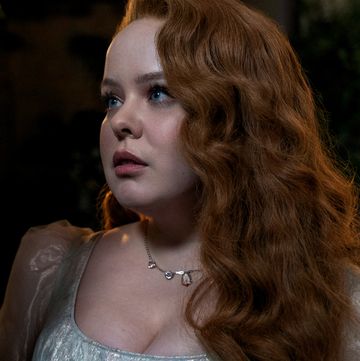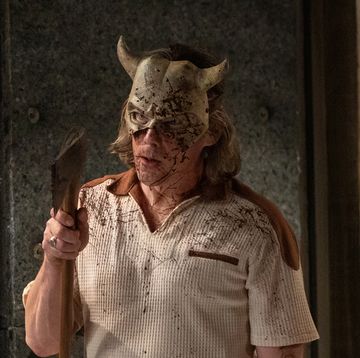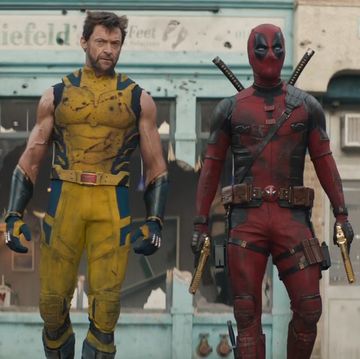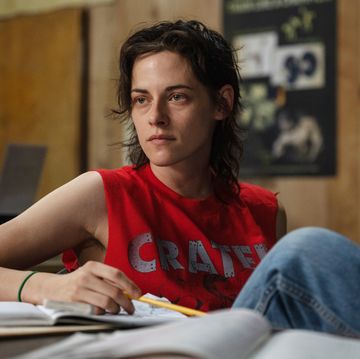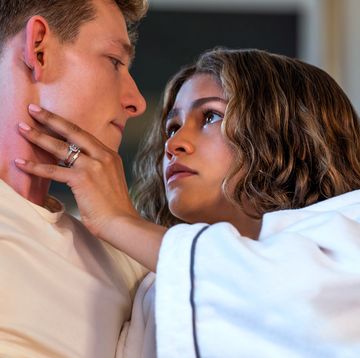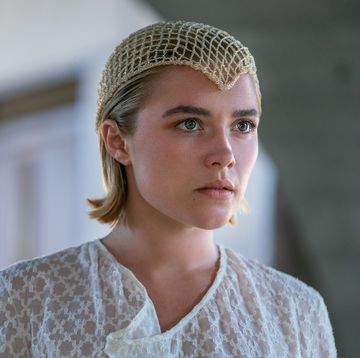When one thinks of World War II, all thoughts immediately go to the heartbreaking loss of life and the immeasurable trauma attached to the suffering of war.
What you don't automatically think of is haute couture — ballgowns and fashion houses — or rolls of silk material being bartered for lives. And yet, the world of fashion was also embroiled in the ugliness of war.
Apple TV+'s latest drama The New Look delves into fashion's murky history in WWII through the lives of renowned fashion designers Christian Dior and Coco Chanel, played by Ben Mendelsohn and Juliette Binoche.
Game of Thrones star Maisie Williams bears the same resolute expression as her GoT character Arya Stark, this time as Resistance fighter Catherine Dior.
While Catherine's role in the Resistance has been depicted as morally unambiguous, it becomes very apparent within mere moments of air time that her older brother Christian fell somewhere in the grey.
"Is it true that during the Nazi occupation of Paris, Coco Chanel closed her atelier and refused to design dresses for the Nazis whilst you kept designing and making money?"
This question is posed to the iconic designer 10 minutes into the debut episode.
"There is the truth," he replied, "but there's always another truth behind it." This is a fact viewers quickly come to learn.
Chanel's ties with the Nazis were, in fact, much more insidious than designing cocktail dresses for the Third Reich's wives — but nothing is black and white.
Described as both "a wretched human being" (New York Times) and "an enormous opportunist who did what she had to do to get along" (biographer Hal Vaughan), Chanel had a complicated involvement in the war.
The New Look gives us some insight into their experience, but what really happened to Christian Dior and Coco Channel during World War II?
What happened to Christian Dior during WWII?
Christian Dior did, in fact, design dresses for Nazi wives and girlfriends, but his reasoning for doing so was not straightforward.
In 1941, Dior returned to Paris after serving in the war in the south of France and began working for Lucien Lelong's fashion house. As Lelong's employee, Dior was one of many tasked with designing clothes for Nazis.
However, his reason for doing so was reported to be more altruistic than for profit.
Under the Nazi regime, some of the biggest names in fashion were being forced out of the country, leaving many Parisian civilians out of work. The Germans sought to move the European fashion hub from Paris to Berlin and Vienna.
Thanks to the efforts of Lelong, Dior and other designers — who travelled down to Berlin to argue their case — they were able to persuade the Germans to leave the French fashion industry alone.
However, their 'victory' came at a cost.
The French were no longer allowed to export or photograph their fashion, leaving the industry with a home market that was ultimately only available to rich Germans and wealthy collaborators — the only ones who could afford such luxuries under Nazi occupation.
For Dior, it was a matter of civic duty and pride, but it was an imperfect solution that came with a bitter caveat.
How did Dior create the New Look?
The New Look — for which the drama was named — was coined in 1946 by Harper's Bazaar's editor-in-chief Carmel Snow. The exciting, contemporary designs she was referring to were the cinched waists and full-bodied skirts with bold, vibrant, colourful designs — a far cry from what France had known before and in stark opposition to the cleaner, sleeker, more classic look Chanel favoured.
"What he did was create a space of beauty," said Laurence Benaïm, the author of several highly regarded books on Dior.
"He reinvented the taste of seduction."
Dior, who showed off his novel collection for the first time in his studio on Paris's Avenue Montaigne, would later explain the inspiration behind his designs in his autobiography:
"In December 1946, as a result of the war and uniforms, women still looked and dressed like Amazons," he wrote. "But I designed clothes for flower-like women, with rounded shoulders, full feminine busts, and hand-spun waists above enormous spreading skirts," (via Washington Post).
This was the first collection that he'd done under his own name, and it elevated the 42-year-old couturier to a level of success he had never experienced before.
But not all were enamoured by his re-imaging of French fashion post-war. Chanel dismissed his efforts and took jabs at his sexuality when she declared: "Look how ridiculous these women are… wearing clothes by a man who doesn't know women, never had one, and dreams of being one" (via Daily Mail).
Was Coco Chanel a Nazi secret agent?
With the outbreak of WWII in 1939, Chanel closed her couture house and moved into the Ritz Paris hotel.
She remained there until her move to Switzerland in 1944 despite the hotel becoming the Nazi headquarters when the Germans occupied France in 1940 (via Britannica).
During that time, Chanel became romantically involved with German intelligence officer Baron Hans Günther von Dincklage, known to his friends as 'Spatz'.
Author Hal Vaughan, who researched Chanel extensively for his book Sleeping with the Enemy, detailed how the designer used her Nazi connections to free her nephew André Palasse, who was a German prisoner-of-war.
However, while The New Look depicts this as the turning point at which Chanel reluctantly became a Nazi collaborator, Vaughan's insight differs.
The New Look implies that Chanel was coaxed into entering a relationship with the Nazis, starting with Chanel wresting sole control of the Chanel perfume brand away from the Jewish Wertheimer brothers, whom she co-founded the company with.
However, Vaughan documents that Chanel used her ingenuity to reclaim her company under the Nazis' Aryanization of property laws, insinuating that she was the instigator (via The New York Times).
Unfortunately for Chanel, the Wertheimers had preemptively sold their shares to a non-Jewish businessman, rendering Chanel's efforts fruitless.
Where both the drama and historical narrative are aligned is over Chanel's covert Nazi mission dubbed 'Modellhut', under which she used the code name 'Westminster' — owing to her former romance with the Duke of Westminster.
Under Modellhut, Nazi chief of SS intelligence General Walter Schellenberg tasked her with getting a message to Winston Churchill.
She was to relay that several leading Nazi members wanted to break ties with Adolf Hitler and broker a separate peace deal with England.
The plan went awry when Chanel's co-conspirator Vera Lombardi (a mutual friend of hers and Churchill's, whom she'd had released from an Italian prison) sold her out, denouncing Chanel and her associates as German spies.
Lombardi went back into custody while Chanel managed to return to the safety of Paris.
While Modellhut was the only mission of Chanel's that has been confirmed, The Guardian did report that the French secret services had files on celebrities including Chanel.
Of Chanel, they disclosed that: "A source in Madrid informed us that Madam Chanel was in 1942-1943 the mistress and agent of Baron Günther von Dincklage.
"Dincklage used to be an attaché at the German embassy in 1935. He worked as a propagandist, and we suspect him of being a [German] agent." This fact was later confirmed.
The file was said to have detailed Coco Chanel as an agent by the Nazi intelligence organisation, the Abwehr.
However, Frédéric Queguineur (in charge of the secret service archives) went on to clarify that while "from the German point of view, they registered her, so it [meant that] she potentially could be a source of information, fulfil a mission, work for them", it didn't make clear whether or not she was "really aware of that".
What happened to Coco Chanel after WWII?
Despite being a Nazi collaborator, Coco Chanel went on to enjoy unprecedented success. What's more, she largely avoided reprimands for her involvement. The question is how?
According to historians, Chanel went to great lengths to bury her Nazi connections.
In 1944, at the end of Nazi occupation, Chanel was arrested and questioned by a French judge.
They had discovered that Chanel had "cooperated with German military intelligence and had been teamed with a French traitor, Baron Louis de Vaufreland" (via The New York Times).
Baron had been outed as a thief and wartime German agent dubbed 'V-Mann' on the German Abwehr documents — meaning he was a trusted agent.
Chanel worked a deal with anti-Nazi partisan Pierre Reverdy (her friend and occasional lover) in which she helped to arrange the arrest of Baron de Vaufreland, hoping that she could distance herself from any accusations.
No charges were ever brought against Chanel, who later claimed her longtime friend Churchill had intervened (via Britannica).
When the haute-couture icon caught wind that Schellenberg was set to publish his memoirs, she paid him and his family off.
What happened to Maisie Williams' Catherine Dior in real life?
Catherine Dior was a French Resistance fighter and Christian's younger sister. In 1944, she was captured by the Nazis, who took her to one of their holdings and tortured her.
Christian Dior tried but failed to secure her release, and so Catherine was deported to Ravensbruck concentration camp in Germany. There, she worked 12 hours a day, becoming weak and malnourished.
Eight months later, when the Allied troops began closing ranks, she and other prisoners of war began to make their way from Ravensbruck to another camp on what was termed a death march.
The death march earned its name because of the brutality of the journey and the numerous fatalities that occurred along the way. Eight days into the march, Catherine escaped.
She was reunited with Christian in May 1945. It is said that the Nazis' treatment of her left her unrecognisable to Christian.
Prior to her capture, Catherine had been a crucial member of the Resistance.
She was tasked with gathering intelligence under the code name Caro and would also transmit information about the movements of German troops and warships.
Her work often required her to take lengthy trips by bicycle to liaise with other Resistance members, putting herself in grave danger (via The Independent).
Catherine became involved with the Resistance in 1941 when she went to buy a radio against the Gestapo's orders. In the shop, she met Resistance fighter Hervé des Charbonneries, with whom she later fell in love.
Catherine survived the war and lived to the age of 91, dying on June 17, 2008.
The first three episodes of The New Look are available to watch on Apple TV+ now, with new episodes airing every Wednesday.
TV writer, Digital Spy Janet completed her Masters degree in Magazine Journalism in 2013 and has continued to grow professionally within the industry ever since. For six years she honed her analytical reviewing skills at the Good Housekeeping institute eventually becoming Acting Head of Food testing. She also freelanced in the field of film and TV journalism from 2013-2020, when she interviewed A-List stars such as Samuel L Jackson, Colin Firth and Scarlett Johansson. In 2021 she joined Digital Spy as TV writer where she gets to delve into more of what she loves, watching copious amounts of telly all in the name of work. Since taking on the role she has conducted red carpet interviews with the cast of Bridgerton, covered the BAFTAs and been interviewed by BBC Radio and London Live. In her spare time she also moonlights as a published author, the book Gothic Angel.

